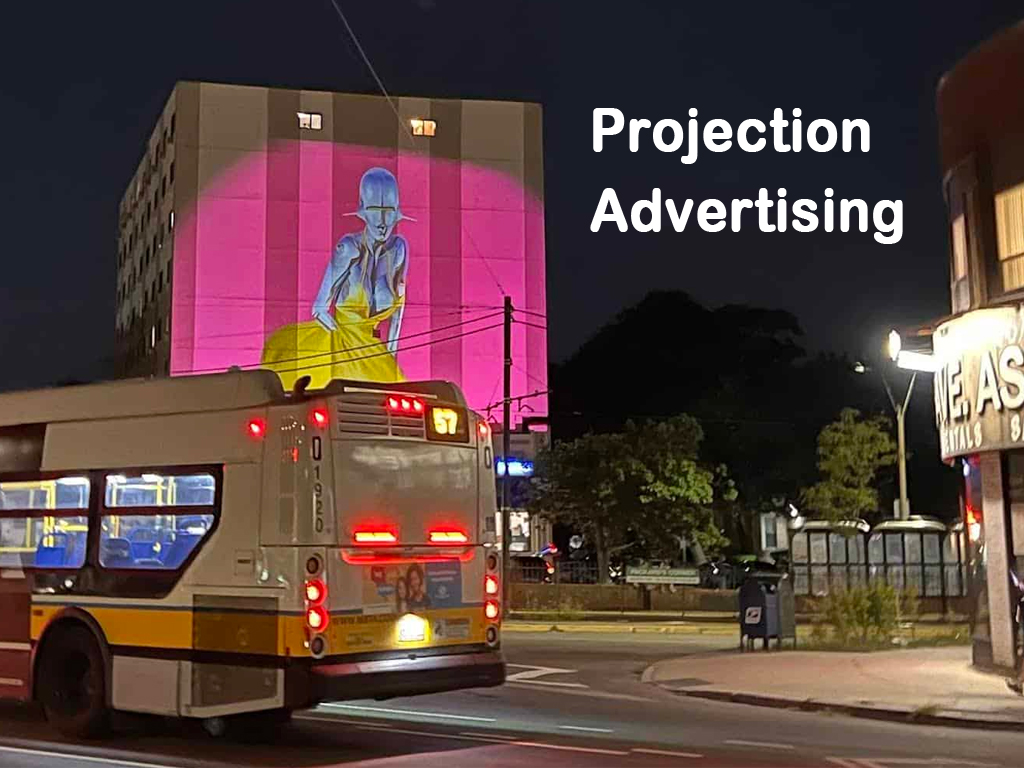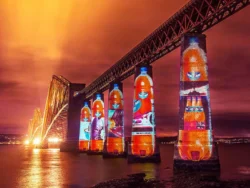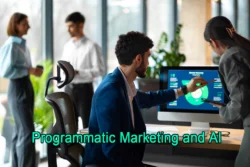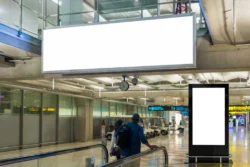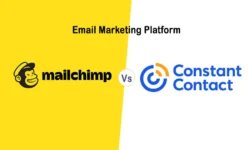Projection advertising, also known as projection mapping or digital projection advertising, is a cutting-edge marketing technique that leverages high-powered projectors to transform static surfaces—such as buildings, walls, or landmarks—into dynamic, visually stunning displays. By utilizing advanced technology, this method creates immersive experiences that captivate audiences and leave a lasting impression. It has become an essential tool for brands looking to stand out in crowded urban environments, making it ideal for product launches, brand campaigns, public art installations, and experiential marketing events.
As we look towards 2025, projection advertising continues to evolve, driven by technological advancements and shifting consumer behaviors. This article explains the mechanics of projection advertising, exploring the instruments and models used, highlighting leading project advertising providers in the USA, and showcasing notable examples of their work. Additionally, it examines the emerging trends that are shaping the future of this innovative field, ensuring that readers are equipped with the latest insights into this dynamic marketing strategy.
How Projection Advertising Works
Projection advertising involves a sophisticated multi-step process to ensure that the projected content aligns perfectly with the target surface, creating a seamless and immersive visual experience. The process begins with surface scanning and 3D modeling, where the target surface—such as a building facade, monument, or natural landmark—is meticulously scanned using laser scanners or photogrammetry techniques to create a precise 3D digital model. This model captures not only the shape and geometry of the surface but also its texture and existing lighting conditions, which are crucial for accurate content mapping. Technologies like LiDAR scanners or high-resolution cameras ensure precision, with software like Autodesk Recap or RealityCapture processing the data into a usable 3D mesh.
Once the 3D model is created, the next step is content creation. Specialized software, such as TouchDesigner, Resolume, or MadMapper, is used to design and animate the content—ranging from static images and full-motion videos to interactive elements and live streaming. These platforms allow for precise mapping of the content onto the 3D model, ensuring that the projection aligns correctly with the surface’s contours. Content is often designed to exploit architectural features, creating illusions of depth, movement, or transformation, such as making a building appear to crumble or morph. Color calibration and gamma correction are critical to ensure visual fidelity across varying surface materials and ambient light conditions.
The projection phase involves deploying high-powered projectors, typically with luminosities exceeding 12,000 lumens, to cast the content onto the surface. Laser projectors are preferred for their brightness (up to 30,000 lumens in some cases), color accuracy, and longevity, with models like the Barco UDM-W20, Christie M 4K25-RGB, or Panasonic PT-RQ35KU commonly used. Depending on the size and distance of the surface, different lenses—long throw for distant projections or short throw for closer setups—are employed to achieve the desired image size and clarity. For large or complex surfaces, multiple projectors may be synchronized using edge-blending techniques to create a cohesive image, with software like Scalable Display Manager ensuring seamless integration.
Finally, real-time adjustments are made using advanced control software that monitors the projection and allows for on-the-fly corrections. Environmental factors like wind, temperature changes, or slight movements in the projection setup can cause misalignment, necessitating dynamic recalibration. Systems may incorporate sensors, such as inertial measurement units or ambient light sensors, to automatically adjust for these variables. Software like Watchout or Pandora’s Box provides real-time feedback and control, ensuring consistent image quality throughout the campaign. This phase is critical for maintaining the illusion of a perfectly integrated display, especially in outdoor settings where conditions can change rapidly.
Instruments and Models Used
Projection advertising relies on a suite of advanced instruments and technologies to achieve its stunning visual effects. Below is a detailed overview of the key components, summarized in a table for clarity:
| Instrument | Description | Example Models/Software |
|---|---|---|
| High-Powered Projectors | Laser projectors with 12,000+ lumens for bright, large-scale projections. Various lenses (long throw, short throw) enhance flexibility. | Barco UDM-W20, Christie M 4K25-RGB, Panasonic PT-RQ35KU |
| Projection Mapping Software | Handles 3D modeling, surface scanning, and content mapping for seamless alignment. | TouchDesigner, Resolume, MadMapper |
| Mobile Units | Vehicles or tripods with projectors and power sources for flexible setups. | Custom-fitted vans, heavy-duty tripods |
| HD Cameras/Drones | Capture footage and assist in precise mapping. | DJI Mavic 3, Canon EOS R5 |
| Low Light Cameras | Monitor projections in low-light environments. | Sony Alpha 7S III |
| Misting Systems | Create mist screens for enhanced visibility in specific applications. | Custom misting rigs |
| Mapping Kits | Calibrate projections for irregular surfaces. | Scalable Display Manager, Pandora’s Box |
- High-Powered Projectors: The core of projection advertising, these devices must deliver high brightness and resolution. Laser projectors, such as the Barco UDM-W20 (20,000 lumens) or Christie M 4K25-RGB (25,000 lumens), offer superior color gamut and durability compared to lamp-based models. Lens options allow for projections ranging from 10 to 100 meters, with throw ratios tailored to the setup. For example, a long-throw lens (1.5:1 to 3:1) is ideal for distant building facades, while a short-throw lens (0.8:1) suits closer installations.
- Projection Mapping Software: Software is pivotal for aligning content with the 3D model. TouchDesigner excels in real-time interactive content, supporting complex animations and sensor inputs. Resolume is favored for its VJing capabilities, enabling quick content switching for live events. MadMapper offers intuitive interfaces for mapping multiple projectors, with features like edge blending and keystone correction to handle irregular surfaces.
- Mobile Units: For guerrilla or temporary campaigns, mobile units—custom vans or trucks equipped with projectors, generators, and cooling systems—provide flexibility. Stationary setups use heavy-duty tripods or rigging systems to ensure stability, especially in windy conditions.
- Additional Equipment:
- HD Cameras and Drones: Drones like the DJI Mavic 3 capture aerial scans for large surfaces, while cameras like the Canon EOS R5 provide high-resolution imagery for photogrammetry.
- Low Light Cameras: Devices like the Sony Alpha 7S III ensure accurate monitoring in dim environments, critical for nighttime projections.
- Misting Systems: Used in open spaces, misting systems create a semi-transparent canvas for projections, often seen in festival or event settings.
- Mapping Kits: Tools like Scalable Display Manager or Pandora’s Box facilitate multi-projector setups, offering calibration for alignment and color consistency.
- Content Types: Projection advertising supports diverse content, including static images for brand logos, full-motion videos for storytelling, live streaming for real-time engagement (e.g., sports scores), and interactive elements that respond to audience inputs via sensors or mobile devices.
Leading USA Providers and Their Projects
Several companies in the USA specialize in projection advertising, delivering innovative campaigns that leverage cutting-edge technology. Below are key providers and their notable projects:
- Alt Terrain: A leader in guerrilla projection advertising, Alt Terrain transforms urban landscapes into dynamic advertising spaces. Based in New York, they excel in securing permissions for high-value surfaces and executing complex projections. Their portfolio includes:
- Bud Light Outdoor Event Marketing (Nashville, TN): A vibrant projection turned a city block into a festive display, enhancing brand visibility during a major event.
- Adidas Projection Mapping (Los Angeles, CA): A dynamic campaign mapped Adidas’ branding onto iconic buildings, generating buzz for a product launch.
- Blade Runner Movie Release (Boston, MA): A cinematic projection brought the film’s dystopian theme to life, driving social media engagement.
- Grassroots Advertising Inc.: Known for experiential marketing, Grassroots integrates projection with sensory enhancements. Their projects include:
- Tangerine NBA Finals Projection (Toronto, Canada): Projected live game scores and post-game creatives, creating a communal fan experience.
- Beefeater Sensory Projection: Combined visuals with a strawberry-scented canon, engaging multiple senses for a memorable campaign.
- MASSIVEMEDIA: Specializes in video projection advertising, particularly sidewalk displays. They create digital billboards on urban surfaces, reaching pedestrians with dynamic content.
- American Guerilla Marketing: Focuses on immersive, unconventional projections, often incorporating augmented reality to blur physical and digital boundaries.
- Gorilla Media: Offers strategic light projection for events and launches, using static images, videos, and live streams to drive engagement and shareability.
The Future of Projection Advertising
Projection advertising is poised for significant growth in 2025 and beyond, driven by technological advancements and evolving consumer expectations. Key trends include:
- Digital Out-of-Home (DOOH) Growth: Projection mapping, as part of DOOH, is expected to grow at a CAGR of 10.7% from 2025 to 2030, driven by dynamic, real-time content capabilities.
- Sustainability: Companies are adopting energy-efficient LED projectors and solar-powered solutions to align with eco-friendly practices, reducing environmental impact.
- Mobile Technology Integration: Interactive elements like QR codes and NFC enable smartphone engagement, bridging physical and digital experiences.
- Experiential Campaigns: Large-scale, immersive installations, often with augmented reality, create memorable experiences that resonate emotionally.
- AI and Data-Driven Personalization: AI optimizes ad placements and personalizes content using real-time data, enhancing targeting and effectiveness.
- Programmatic Buying: Programmatic DOOH extends to projection advertising, streamlining ad space transactions and improving ROI with AI-driven attribution.
- Retail Media Integration: In-store projection advertising is set to grow, engaging shoppers at the point of purchase as part of the retail media trend.
Benefits and Challenges
Benefits:
- High Visibility: Captures attention in high-traffic areas with large-scale, vibrant visuals.
- Creative Flexibility: Supports diverse content, from static images to interactive animations.
- Social Media Impact: Generates shareable content, amplifying brand reach.
- Temporary Installations: Avoids permanent structures, reducing long-term costs.
Challenges:
- Lighting Requirements: Best in dark environments, limiting daytime use.
- High Costs: Initial setup, including projectors and software, can be expensive.
- Legal Permissions: Public or private property projections require complex permits.
- Technical Complexity: Demands skilled technicians for calibration and maintenance.
Conclusion
Projection advertising represents a transformative approach to marketing, blending advanced technology with creative storytelling to engage audiences in unique ways. By utilizing high-powered projectors, sophisticated mapping software, and mobile units, companies can create stunning visual displays that turn ordinary surfaces into extraordinary advertising platforms. Leading USA providers like Alt Terrain, Grassroots Advertising Inc., MASSIVEMEDIA, American Guerilla Marketing, and Gorilla Media have demonstrated the power of this technique through projects like Adidas’ Los Angeles campaign, Bud Light’s Nashville event, and Tangerine’s NBA finals projections. Despite challenges like high costs and the need for dark environments, the evidence suggests that projection advertising’s ability to captivate and inspire makes it a valuable tool for modern marketers. As technology advances, with trends like AI integration and sustainability shaping its future, this innovative method is likely to continue evolving, offering even more creative possibilities for brands and events.
